Mindfulness Training Course In Hongkong
Our corporate training course is also available in Kowloon, Sha Tin, Tsuen Wan, Tuen Mun, Yuen Long Kau Hui, Tseung Kwan O, Tai Po, Sai Kung, Yau Ma Tei, Mong Kok, Kwun Tong, Tung Chung, Fanling – Sheung Shui, Sheung Wan, Causeway Bay, Wan Chai, Tin Shui Wai, Tai Kok Tsui, Ma On Shan, Cheung Sha Wan, Hung Hom, Admiralty, Central, Tsim Sha Tsui, Tsing Yi, North Point, Lam Tin, Aberdeen, Wong Tai Sin, Sham Shui Po, Lantau Island, Repulse Bay.
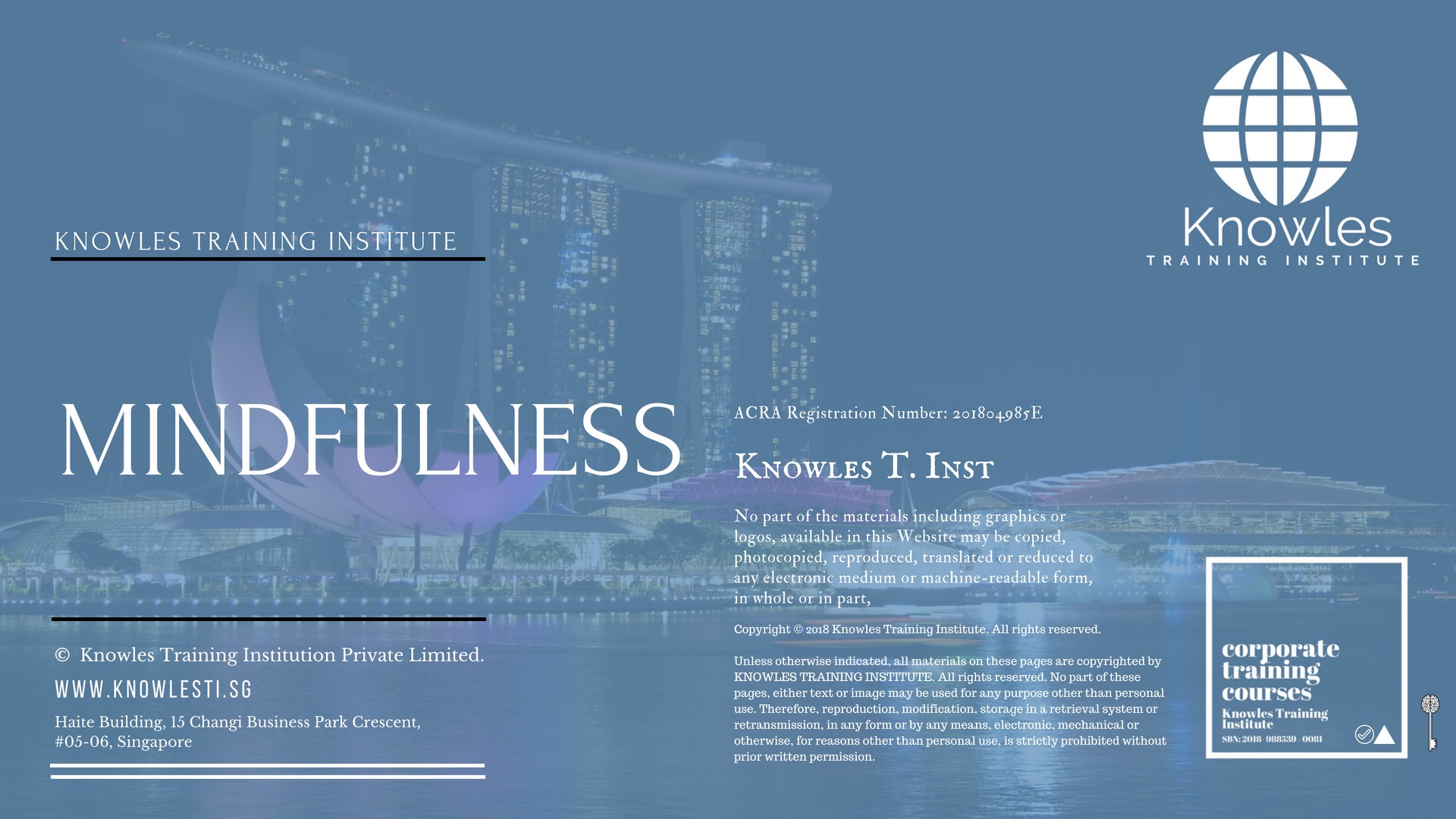
About This Mindfulness Training Course in Hong Kong
Mindfulness Course in Hong Kong
We practice mindfulness by keeping up a familiarity with our reflections, sentiments, real sensations and the encompassing condition. To practice mindfulness, it requires full attention to the surroundings. It is an ability to understand what is going around, what we are doing and, empower us to control our emotional intelligence and reaction towards situations.
Mindfulness includes non-judgment, implying that we focus on our thoughts and sentiments with the frame of mind of a fair observer without trusting them or thinking about them altogether. Mindfulness can enable us to appreciate life more and to comprehend better. You can find a way to create it in your own life. We already can use this ability, and it does not require a drastic change; just a little cultivation is needed.
An essential piece of mindfulness is reconnecting with our bodies and the sensations they experience, awakening the sights, sounds, scents and tastes of the present minute. That may be something as straightforward as the vibe of a railing as we walk upstairs.
The vital part of mindfulness is a consciousness of our thoughts and feelings as they happen. Awareness of this sort causes us to see indications of stress or nervousness prior and encourages us to manage them better.
Creating mindfulness can make changes in the thoughts and translations brain makes, changing the pictures inside the brain enables to change feelings. Mindfulness also helps in managing stress and anxiety, to make choices which reduce the burden on the brain. It also makes person stress free with an increase in productivity, to practice this skill is also healthier; it gives more awareness about the body and how to improve situations.
Mindfulness is one of the properties of emotional intelligence and acts as an essential factor in making progress. The stunning advantages of mindfulness and thoughts have been appeared to change the regions related to memory.
In this course, individuals discover why mindfulness is the primary consideration in progress, figure out how to survey and lift mindfulness, understand the psychological impact of mindfulness, and learn how to practice self-observation skill in daily life actively.
Who Should Attend This Mindfulness Training Course in Hong Kong Workshop
This Mindfulness Training Course in Hong Kong workshop is ideal for anyone who would like to gain a strong grasp and improve their Mindfulness.
All Staff Within An Organisation
Managers
Team Leaders
Executives
Assistants
Officers
Secretaries
Group Size For This Mindfulness Training Program in Hong Kong
The ideal group size for this Mindfulness course in Hong Kong is:
Minimum: 5 Participants
Maximum: 15 Participants
Course Duration For This Mindfulness Skills Course in Hong Kong
The duration of this Mindfulness Training Course in Hong Kong workshop is 1 full day. Knowles Training Institute Hong Kong will also be able to contextualised this workshop according to different durations; 3 full days, 2 days, half day, 90 minutes and 60 minutes.
1 Full Day
9 a.m to 5 p.m
Mindfulness Course in Hong Kong Benefits
Below Is The List Of Course Benefits Of Our Mindfulness Course in Hong Kong
- Explore Behavioural Changes.
- Develop A Way To Regulate And Control Your Emotions.
- Manage Emotions To Drives Self-Confidence And, Beliefs.
- Enables To Define Life Goals.
- Polish Active Management Skills.
- Improve Observation Power.
Mindfulness Training Course in Hong Kong Objectives
Below Is The List Of Course Objectives Of Our Mindfulness Course in Hong Kong
Often we miss essential information in our present circumstances when we dwell on on the past or worry about the future. It takes practice to develop a state where you are always aware of your present moment. By being in the present, you have a perspective that allows you to learn from the past without feeling overwhelmed with resentment and regret. You can also prepare for the future without it overwhelming you with anxiety or dejection. By putting into practice the guidelines in this module, you will reframe your mental and emotional outlook to operate in the present moment.
- Defining mindfulness
- Develop techniques to make oneself more attentive to the present moment
- Understand the utility of one’s emotions and its value
- Learn how to counter distorted-thinking and recognise it
- How to foster genuine positive emotions
- Become more fully present in social interactions
Course Content For This Mindfulness Training Course in Hong Kong
Below Is The List Of Course Content Of Our Mindfulness Training Course in Hong Kong
Mindfulness Courses in Hong Kong – Part 1: What Is Mindfulness?
People often confuse the concept of mindfulness with the idea that one should “stop and smell the roses.” However, if you found yourself with your nose stuck deep into a flower in a field where an angry bull was bearing down on you, this would be the exact opposite of being mindful. Mindfulness is a state of mind where you are fully conscious and engaged in the present moment and with the demands of the present moment
- Buddhist Concept
- The notion of mindfulness comes to us through the Buddhist religion. The word “mindfulness” is one translation of the Pali word sati(Sanskrit smrti). Other interpretations of this word include “awareness” and “memory.”
- Bare Attention
- One feature of mindfulness is the cultivation of bare attention. Bare attention is attention that is lacking judgment or elaboration. Whenever we are challenged with a new situation, we are enticed to try and consider what this unique situation means to us.
- Psychological Concept of Mindfulness
- Although mindfulness arose as a Buddhist concept, psychologists from the 1970s to the present have analysed the effects of Buddhist mindfulness meditation techniques and found that these are efficient in decreasing anxiety and reducing relapse rates in both depression and drug addiction. Modern studies have found that incorporating mindfulness into your life can enhance positive emotions, improve the immune system, and reduce tension.
- Memory
- To this point, we have concentrated on just one aspect of mindfulness, that of bare attention in the immediate moment. However, as mentioned earlier, another translation of the word sati is memory, and there is a very good reason for this. Paying close attention to your immediate moment and environment sounds like an advantageous practice, and for the most part, it is.
Mindfulness Courses in Hong Kong – Part 2: Practicing Mindfulness
Mindfulness is a natural state of being. Throughout our lives, we are frequently in this state without realising it. If you have ever heard a noise at night and went to investigate, the level of attention that you bring to that situation is an excellent example of being mindful. However, we frequently divide our attention and, by necessity, we will selectively ignore aspects of our environment. When watching a sporting event on television, for example, a particularly enrapt fan might tune out a conversation that is occurring around him or her in order to pay closer attention to the game. If the sports fanatics in this scenario consciously thought about paying attention to the conversations around them rather than the game on television, they could. In this sense, mindfulness is a mental skill that you can develop through practice.
- Attention
- While practising mindfulness, whether through meditation or in a given time, you want to pay consideration to whatever comes up. For example, when you concentrate on your breath, note whether you are breathing in deeply or shallowly. Is your breath cold or warm? Fast or slow? Through your mouth or nose?
- Acceptance
- When you meditate for mindfulness or discover yourself in a mindful state, it is essential to accept things as they are without judgment. At some point, you may elect to act to change things, but initially, you want to take what you experience for what it is.
- Mindfulness Meditation
- The best method to practice being mindful is through a consistent program of meditation. Keep in mind that not all meditations are to make you more mindful. Transcendental meditation and mantra meditation might enhance mindfulness as a side effect, but these aim at an entirely different result.
- Scanning
- One method that Kabat-Zinn’s advance to mindfulness meditation includes is called scanning or body scanning. Once you are used to it, you can do it without the necessity of guided meditation, but one alternative for beginners is to record your voice talking yourself through the body scan.
Mindfulness Courses in Hong Kong – Part 3: Emotional Intelligence
While improving mindfulness is helpful as an intervention between our emotional cues and our reactions, it will not prevent us from feeling emotions or having angry thoughts at times. Nor is this desirable. In order to make effective use of the intervention that mindfulness provides, we need to understand better how we feel, why we feel, and what to do with those feelings. Psychologists use the term emotional intelligence to refer to this understanding.
- The Purpose of Emotions
- You may have heard it stated that all emotions are valid. While this is true, it does not mean that you are well within your rights to throw a temper tantrum whenever you do not get what you want.
- High-Performance Emotions
- While all emotions are valid, and all feelings are helpful because they provide you with relevant data, some emotions help you to perform better at your job. These high-performance emotions are enthusiasm, confidence, tenacity, and optimism. High-performance emotions increase our arousal levels while still maintaining a broad and open focus.
- Swing Emotions
- The swing emotions are named that because they can be instrumental in enhancing your situation, or they can help make an unfortunate circumstance even worse. The swing element comes from how you prefer to utilise these emotions. Swing emotions are there to inform us that something is not right in our environment.
- Blue Emotions
- The third class of emotions is blue emotions. These emotions are marked by low arousal levels as well as a narrowed focus. Blue emotions constitute dejection, depression, and disappointment.
Mindfulness Courses in Hong Kong – Part 4: Cognitive Distortion
Whenever you feel emotionally ill at ease, it is completely natural for your thinking to become distorted as well. During high arousal periods when our thoughts race, we can make both logical and intuition leaps that may or may not hold up when further examined. When our focus narrows, we close ourselves off to possible information and circle over the same types of destructive thoughts repeatedly. Cognitive psychologists refer to these as automatic thinking, which falls into various patterns. Using mindfulness to identify what our thoughts are doing helps us to make the necessary changes in our thinking which will allow us to improve the situation. These next two modules focus on various kinds of distorted thinking patterns.
- Dichotomous Reasoning
- Dichotomous reasoning suggests that you think in terms of hyperbole, extremes, and black and white. When focusing on your thoughts, caution to words such as always, never, everyone, nobody, the best, the worst, etc.
- Magnification and Minimisation
- Typically people who magnify or minimise circumstances tend to gravitate towards one type of contortion. Magnification occurs when you blow things out of proportion. It is also often referred to as “making a mountain out of a molehill.”
- Filtering
- Filtering occurs when you only hear the negative someone tells you when their statement is a mixture of negative and positive. Another form of filtering is called disqualification. Disqualification occurs when you automatically discount something positive someone says to you as either an impossible statement, one made from naiveté or one made for ulterior purposes.
- Jumping to Conclusions
- Another kind of distorted thinking pattern happens when you conclude what someone else thinks, feels, or will do in the future with little to no data. Two other kinds of sub-patterns fall under jumping to conclusions: mind-reading and fortune-telling.t
Mindfulness Courses in Hong Kong – Part 5: Cognitive Distortion 2
As you become more mindful and aware of your distorted thinking in times of distress, you may notice your tendency to fall into specific distorted thinking patterns more so than others.
- Destructive Labelling
- Destructive labelling occurs when you characterise something or someone in a generalised and negative fashion. For example, if you are a supervisor and an employee comes in late to work, thinking that this person is irresponsible or does not care about their job is an example of destructive labelling.
- Personalising
- While this distorted thinking pattern can be comparable to jumping to conclusions, it does so in a more definite way, by relating everything to yourself or by taking responsibility for something over which you have no control.
- Blaming
- A similar distorted thinking pattern to personalising is accusing. Whereas the personalising distorted thinking pattern relates everything to yourself, blaming occurs when you focus more on whom you think is at fault in a situation rather than focusing on a resolution to the circumstance.
- The Tyranny of the Should
- This distorted thinking pattern is imperative thinking. It occurs when you fixate on how you think a person or situation should or should not be, rather than reality. It is another example where our assumptions about a situation are not helpful.
Mindfulness Courses in Hong Kong – Part 6: Mindfulness-Based Cognitive Therapy
Identifying distorted thoughts and counteracting them is one option for how you can choose your reaction to emotions. Typically to have the wherewithal to identify an emotion or a distorted thinking pattern, you have to be in a place of calm. While correcting a distorted notion with logic sounds simple, in practice it isn’t always the most practical approach. An alternative to choosing a reaction to your emotions is to do nothing altogether. You have to get to a point where you see your “self” – the person you refer to when you say “I” – as separate from your thoughts and emotions. Mindfulness-Based Cognitive Therapy (MBCT) seeks to foster this form of detachment, which has been vitally helpful for those who suffer from extreme anxiety in particular.
- Mental Modes
- Most forms of MBCT theorise that the mind operates with many subsystems. You have subsystems that constitute what you take in from your senses, for example. Most theorists agree that the two main subsystems or modes correspond with an emotional side and a logical side.
- Doing Mode
- Another way of thinking of the two principal modes of cognition – emotional and logical – is in terms of action: a doing mode and a being mode. The doing mode is goal-oriented and engages when you feel things aren’t as they should happen.
- Metacognitive Awareness
- Mindfulness comes in handy in being able to consciously switch from being mode to doing mode or vice versa because it helps you to develop metacognitive awareness.
Mindfulness Courses in Hong Kong – Part 7: Mindfulness & Gratitude
Becoming mindful of your mental and emotional states, logically counteracting your distortions in thinking, or detaching yourself from them – all of these approaches to handling emotions will reveal two fundamental truths about the emotions: first, they are transitory; and second, the “negative” emotions tend to attract the most attention. It is perfectly natural to notice and even fixate on the negative – all the things in your life or in others’ lives that are going badly. The positive emotions, such as optimism and enthusiasm, they come and go, and frequently we take them for granted. There is a way to keep yourself oriented towards the positive, however, and being positively oriented helps cultivate the high arousal, high-performance emotions that can be the difference between a job that is tedious and a job that is rewarding. The secret is cultivating a sense of gratitude.
- What is Gratitude?
- Gratitude points to that in our life for which we are grateful. This feeling of gratefulness can be extended to some origin, and for religiously minded people, this is often the case. Nonetheless, you don’t have to be religious to perceive gratitude.
- Gratitude Journal
- Oprah Winfrey once remarked that the single most important thing she’s ever done was to write five things that she’s grateful for in a journal at the beginning of each day. And the science supports her.
- An Exercise in Mindfulness and Gratitude
- In addition to keeping a daily gratitude journal, there are multiple ways to cultivate an “attitude of gratitude.”
- Forming a Habit
- This training course comprises incorporating certain activities into daily practice. At this point, you have been encouraged to perform the following things at least once a day: Mindfulness reflection for 10 to 20 minutes or list five things for which you are appreciative in your gratitude journal.
Mindfulness Courses in Hong Kong – Part 8: Cultivating the High-Performance Emotions
To do better at a task, be attentive to how you think and feel. Approach a task with the right attitude by being grateful and positive. Swing emotions such as anger and anxiety may motivate us to improve our circumstances, but being able to incorporate emotions by high arousal and a broader focus will improve our performance in both our professional and personal lives.
- The Emotion-Cognitive-Behavior Triangle
- All emotions have three components that operate together, and you can think of them as a triangle. Emotions also have the quality of being infectious. For example, when someone greets you, you feel an urge to smile back.
- Cultivating Enthusiasm
- Enthusiasm is a get-up-and-go emotion. When you notice yourself procrastinating, you lack enthusiasm. Military leaders and coaches of athletic teams understand that when their groups are collectively more passionate, they will perform better.
- Cultivating Confidence
- Being confident is a delicate balance that multiple people have trouble maintaining. On the one hand, overconfidence can lead to an arrogance that induces individuals to view themselves as better than or more superior than other people. On the other hand, a lack of confidence causes self-doubt that will inhibit creativity and can lead to sad emotions such as dejection and depression.
- Cultivating Tenacity
- Tenacity is that sense that you are going to see something through no matter what. When we discover ourselves confronted with large or challenging tasks, we often feel overwhelmed.
Mindfulness Courses in Hong Kong – Part 9: Mindfulness in Customer Service
Businesses can only be fruitful to the degree that they keep their customers happy. A single bad customer service experience can affect a business as drastically as numerous positive customer service experiences, so it’s vital to approach these types of interactions with a clear and mindful focus and a positive outlook, even when it appears to be a painful experience, especially then.
- Individually Focused
- When you operate in a field where you interact with customers, it is essential to prioritise, and your customer should be your highest priority. Regardless of your position in the company hierarchy, whether you’re at the entry-level or you’re an executive, your customers are ultimately your boss, since, without them, there is no company.
- Active Listening
- We cannot overestimate the value of listening. However, listening requires more than merely hearing the words the customer says. Acquiring the skills of active listening makes sure that you not only hear the words your customers speak but that you understand your customers’ concerns on a deeper level.
- Building a Rapport
- Active listening is only the first step towards building a rapport with your customer. A rapport is a state of harmony between you and another person or group.
- Timing
- One of the most important aspects of a mindful approach to customer service is being aware of your customers’ moods and expectations. It includes choosing the proper timing in your interactions.
Mindfulness Courses in Hong Kong – Part 10 – Mindfulness & Leadership
As you develop a greater awareness of the interplay of your thoughts and emotions, you will find that you have a leg up on your peers. Practising mindfulness helps to make you a better leader, and modelling mindfulness for the rest of your co-workers helps to make your corporate culture a more positive and productive one. While the recommended approach to practising mindfulness has been to engage in mindfulness meditation for 10 to 20 minutes a day, this serves well as an introduction. To take your mindfulness practice to another level, engaging in two twenty-minute meditation sessions per day is ideal. A mindful approach to leadership will enhance your mental toughness, increase your ability to focus selectively on that which you need to focus on, improve your capacity to feel compassion, and loosen the constraints we naturally place upon ourselves that inhibit our creativity. When studying these aspects of mindful leadership, it is essential to remember that each concept overlaps and builds upon all the other concepts.
- Mental Resilience
- The United States Military Academy at West Point has recently developed a mindfulness approach to leadership training that focuses on enhancing mental resilience. The West Point model posits that the world has become increasingly volatile, uncertain, chaotic, and ambiguous (VUCA).
- Focus
- While mindfulness is essential in focusing your attention in a neutral and accepting fashion, as a leader, you will regularly find yourself having to decide upon what to focus. Recognising the goals and values of your company and your shared mission is a vital step towards prioritising your focus. Familiarising yourself with a company mission statement can help in this regards.
- Compassion
- Cultivating a genuine sense of compassion for other people is a significant side effect of continuous practice of mindfulness. Compassion indicates that you try in good faith to understand where another person is coming from and the unique challenges that they have to face.
- Creativity
- The flexibility and adaptability that occur with a practice of mindfulness are exceptionally helpful in being creative. Being an innovative leader also means that you provide an environment where creativity is rewarded.
Mindfulness Training Course in Hong Kong Value Added Materials
Each participant will receive the following materials for the Mindfulness course in Hong Kong
Mindfulness Courses in Hong Kong Learner’s Guide
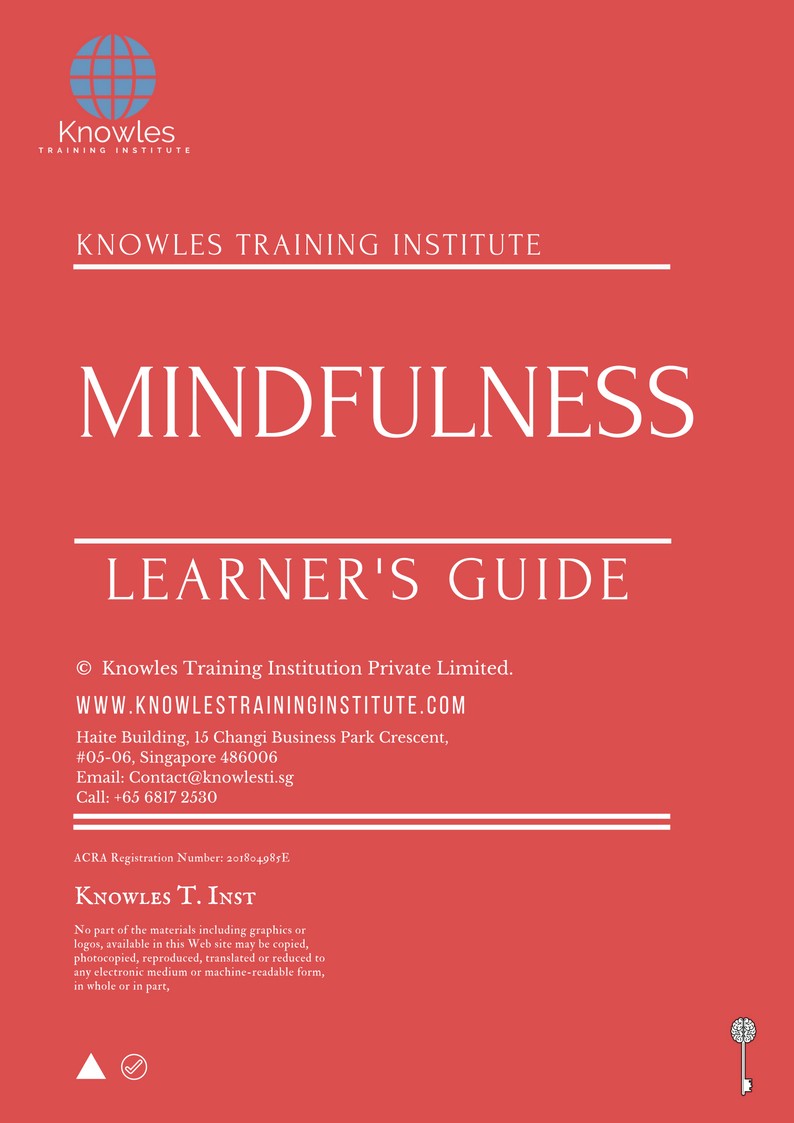
Mindfulness Course in Hong Kong Handouts
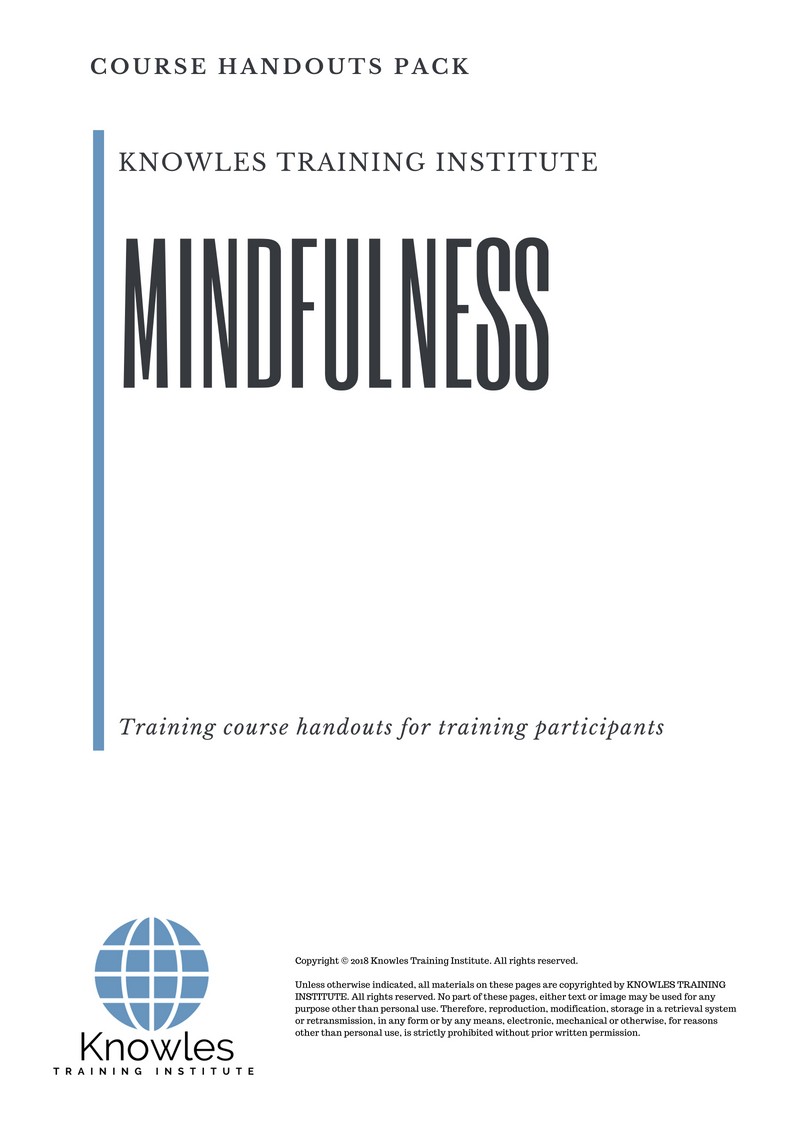
Mindfulness Course in Hong Kong PPT Slides Used During Course
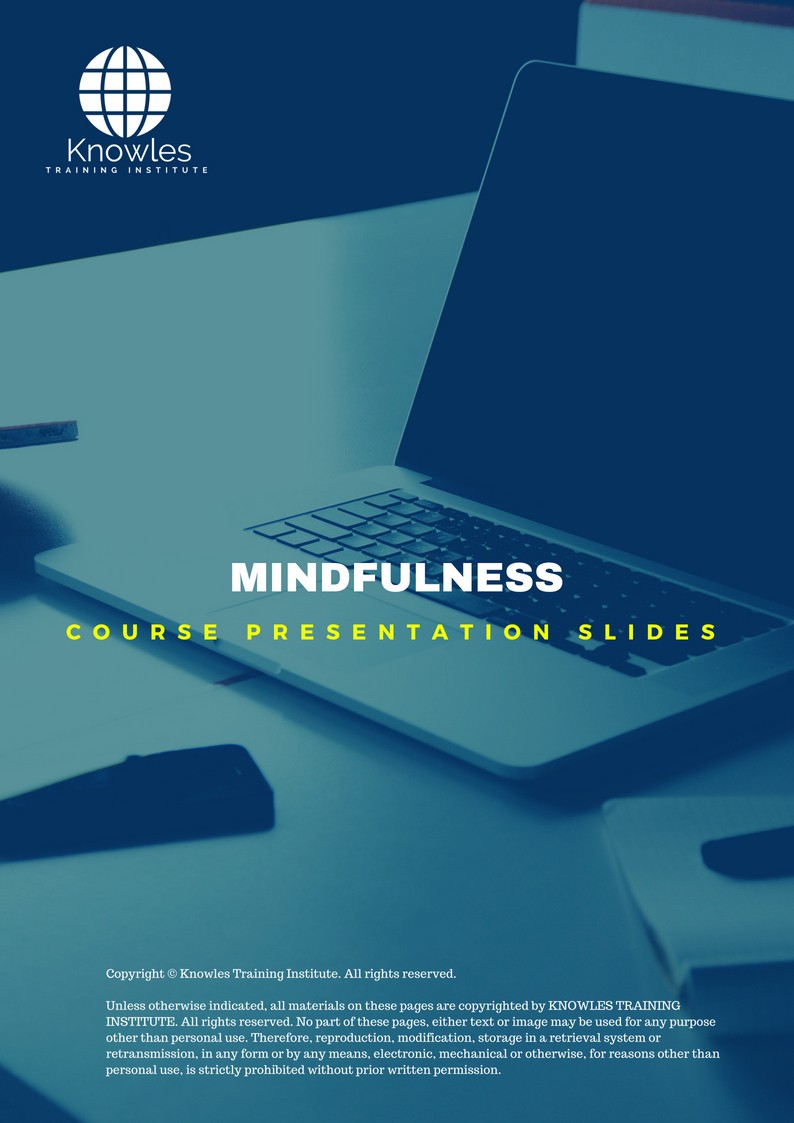
Mindfulness Course in Hong Kong Certification
Each course participant will receive a certification of training completion

Course Fees For Mindfulness Course in Hong Kong
There are 4 pricing options available for this Mindfulness training course in Hong Kong. Course participants not in Hong Kong may choose to sign up for our online Mindfulness training course in Hong Kong.
- USD 1,019.96 For a 60-minute Lunch Talk Session.
- USD 434.96 For a Half Day Course Per Participant.
- USD 659.96 For a 1 Day Course Per Participant.
- USD 884.96 For a 2 Day Course Per Participant.
Discounts available for more than 2 participants.
Upcoming Mindfulness Training Course in Hong Kong Schedule
Contact us for the latest Mindfulness course in Hong Kong schedules:
Email: contact@knowlesti.hk
Message:
Download Mindfulness Training Course in Hong Kong Brochure
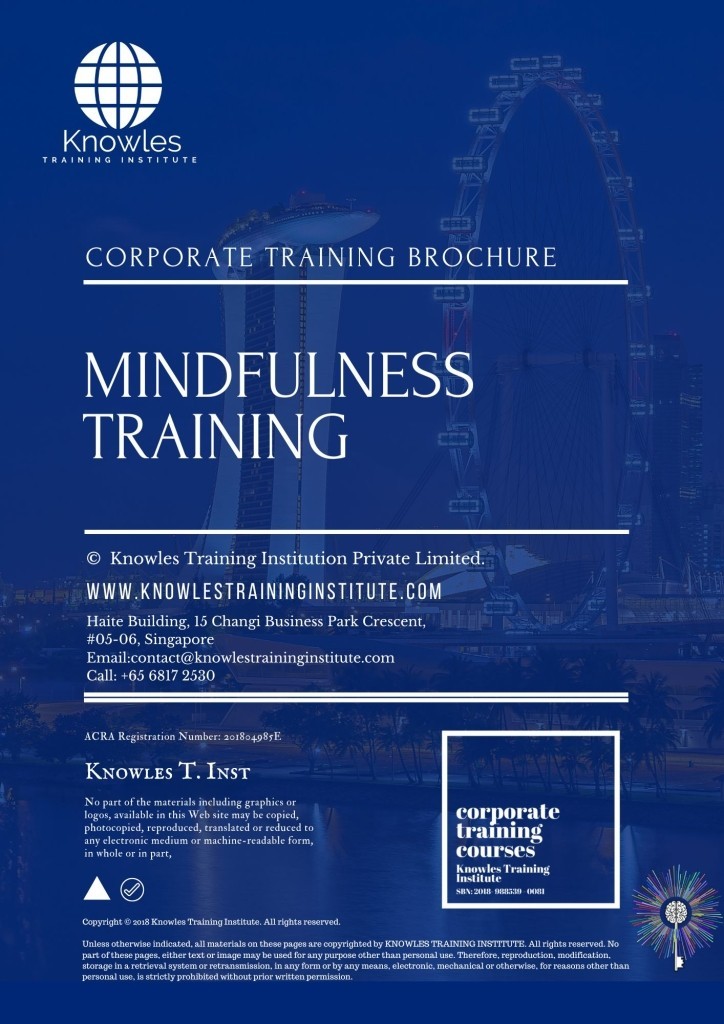
Request for this Mindfulness course in Hong Kong brochure. Fill up the short information below and we will send it to you right away!
Post Training Support: A vast majority of training does not have any effect beyond 120 days. To work, training has to have a strong pre- and post-training component. Post-training reinforcement helps individuals to recall the understanding and ask questions.
Blended Learning: Learning does not occur in the classroom. Virtually everybody prefers distinct ways of learning. Successful learning should have a multi-channel, multi-modal strategy.
- We Understand The Industry: We’ve got a profound comprehension of the business, business design, challenges, strategy and the that our participants are in and have designed the courseware to cater to their professional needs.
- Course Content: Knowles Training Institute’s material is relevant, of high quality and provide specific learning results. Participants will leave the training course feeling as they have gained a strong understanding and will also be in a position to execute what they have learned sensibly.
Course Development — The workshop modules follow a systematic and logical arrangement. This structure helps to ensure that the course material allows the facilitators to deliver the course in a logical arrangement. Consider the subjects as building bricks into learning, our facilitators slowly build towards a comprehensive picture of this entire topic.
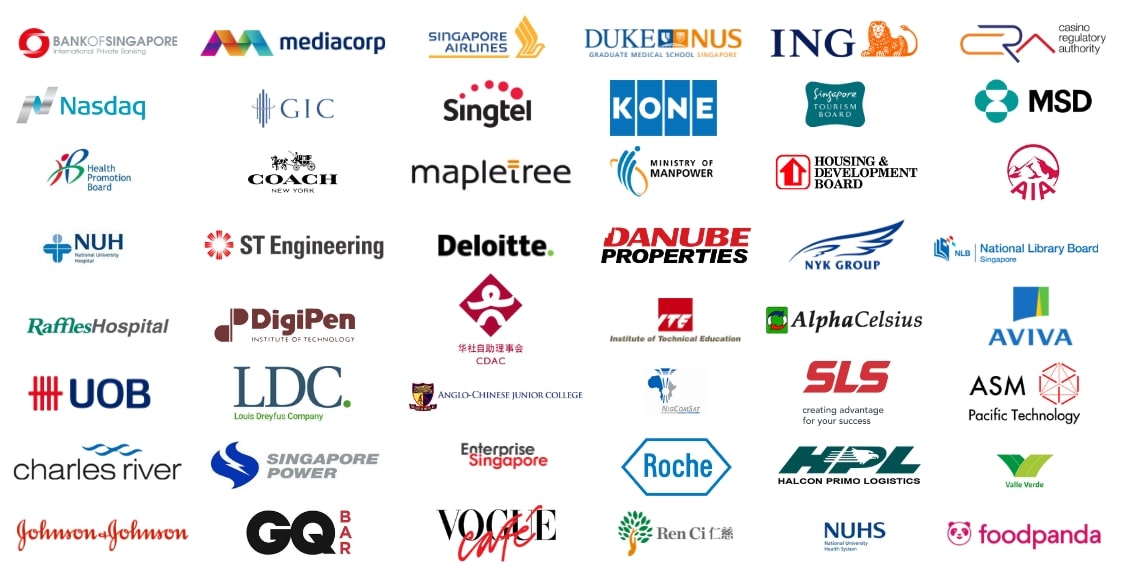

Mindfulness Course Enquiries

Fill up the form and we will get back to you in less than 1 working day.
Alternatively, give us a call to have one of our training consultants contact you. Our corporate training courses can be contextualized to meet your organization’s training needs. Leverage on our large pool of professional trainers and consultants for your organization’s training needs.
Email: contact@knowlesti.hk
We Guarantee 100% Privacy. We Respect Your Privacy. Your Information Will Never Be Shared.


